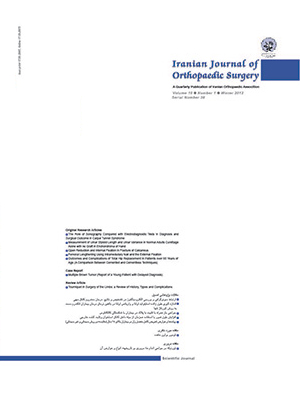Document Type : Original Article
Authors
Abstract
Introduction: Falling is one of the most common and serious health problems in the elderly. As a result of aging, chronic diseases, including joint diseases, increase in the elderly. The aim of this study was to investigate the prevalence of falls and its relationship with joint diseases in the elderly in Urmia.
Methods: This study is a cross-sectional (descriptive-analytical) study in which 200 elderly people were selected by random cluster sampling. Necessary information was collected using a two-part questionnaire including demographic information, joint diseases of the elderly and a history of falls in the elderly in the past year. Data were analyzed using chi-square and logistic regression tests in SPSS v.21 software.
Results: The results of this study showed that the rate of falls in the elderly was 30%. Falling was statistically significantly associated with age, gender, marital status and joint disease. The results of logistic regression showed that the chance of falling of the elderly who had one of the joint and bone diseases such as osteoarthritis, osteoarthritis, osteoporosis, rheumatoid arthritis, gout ... was 6.2 times higher compared to healthy elderly (OR = 6.2 ).
Conclusion: The findings of this study showed that the incidence of falls in the elderly in Iran is relatively high and in accordance with the effective factors obtained in falls in the elderly, including joint diseases, appropriate and effective preventive interventions should be performed.
Keywords
- Boffin N, Moreels S, Vanthomme K, Van Casteren V. Falls among older general practice patients: a 2-year nationwide surveillance study. Family practice. 2014;31(3):281-9.
- Zhou B-Y, Shi J, Yu P-L. Consequence and risk factors of falls-related injuries in community-dwelling elderly in Beijing. Zhonghua liu xing bing xue za zhi= Zhonghua liuxingbingxue zazhi. 2013;34(8):778-81.
- Mazloomymahmoodabad S, Masoudy G, Fallahzadeh H, Jalili Z. Education based on precede-proceed on quality of life in elderly. Global journal of health science. 2014;6(6):178.
- Hartholt KA, Stevens JA, Polinder S, van der Cammen TJ, Patka P. Increase in fall-related hospitalizations in the United States, 2001–2008. Journal of Trauma and Acute Care Surgery. 2011;71(1):255-8.
- Stevens JA, Corso PS, Finkelstein EA, Miller TR. The costs of fatal and non-fatal falls among older adults. Injury prevention. 2006;12(5):290-5.
- Bell AJ, Talbot-Stern JK, Hennessy A. Characteristics and outcomes of older patients presenting to the emergency department after a fall: a retrospective analysis. Medical Journal of Australia. 2000;173(4):179-82.
- Huang HC, Gau ML, Lin WC, George K. Assessing risk of falling in older adults. Public Health Nursing. 2003;20(5):399-411.
- Halil M, Ulger Z, Cankurtaran M, Shorbagi A, Yavuz BB, Dede D, et al. Falls and the elderly: Is there any difference in the developing world?: A cross-sectional study from Turkey. Archives of gerontology and geriatrics. 2006;43(3):351-
- Chu L-W, Chiu AY, Chi I. Falls and subsequent health service utilization in community-dwelling Chinese older adults. Archives of gerontology and geriatrics. 2008;46(2):125-35.
- Stalenhoef P, Diederiks J, Knottnerus J, Kester A, Crebolder H. A risk model for the prediction of recurrent falls in community-dwelling elderly: a prospective cohort study. Journal of clinical epidemiology. 2002;55(11):1088-94.
- Swanenburg J, de Bruin ED, Uebelhart D, Mulder T. Falls prediction in elderly people: a 1-year prospective study. Gait & posture. 2010;31(3):317-21.
- Morris M, Osborne D, Hill K, Kendig H, Lundgren-Lindquist B, Browning C, et al. Predisposing factors for occasional and multiple falls in older Australians who live at home. Australian journal of physiotherapy. 2004;50(3):153-9.
- Jalali MM, Gerami H, Heidarzadeh A, Soleimani R. Balance performance in older adults and its relationship with falling. Aging clinical and experimental research. 2015;27(3):287-96.
- Mahmoodabad SSM, Zareipour M, Askarishahi M, Beigomi A. Prevalence of Falling and its relation with Chronic diseases and Balance of Older Adults in Urmia City. International Journal of Ayurvedic Medicine. 2018;9(4):273-8.
- Hassan B, Mockett S, Doherty M. Static postural sway, proprioception, and maximal voluntary quadriceps contraction in patients with knee osteoarthritis and normal control subjects. Annals of the rheumatic diseases. 2001;60(6):612-8.
- Hall MC, Mockett SP, Doherty M. Relative impact of radiographic osteoarthritis and pain on quadriceps strength, proprioception, static postural sway and lower limb function. Annals of the rheumatic diseases. 2006;65(7):865-70.
- Hadian MR, Olyaei GR, Jalaei S, Mazaheri H. Assessment of balance impairments in patients with knee osteoarthritis. Journal of Modern Rehabilitation. 2010;4(3):18-22.
- Reyes-Ortiz CA, Al Snih S, Markides KS. Falls among elderly persons in Latin America and the Caribbean and among elderly Mexican-Americans. Revista panamericana de salud pública. 2005;17(5-6):362-9.
- Lehtola S, Koistinen P, Luukinen H. Falls and injurious falls late in home-dwelling life. Archives of gerontology and geriatrics. 2006;42(2):217-24.
- Corsinovi L, Bo M, Aimonino NR, Marinello R, Gariglio F, Marchetto C, et al. Predictors of falls and hospitalization outcomes in elderly patients admitted to an acute geriatric unit. Archives of gerontology and geriatrics. 2009;49(1):142-5.
- Bergland A, Jarnlo G-B, Laake K. Predictors of falls in the elderly by location. Aging clinical and experimental research. 2003;15(1):43-50.
- Zhang Y, Chen W. Research overview and progress of the elderly falls. Chin J Gerontol. 2008;9:929-31.
- Coimbra AMV, Ricci NA, Coimbra IB, Costallat LTL. Falls in the elderly of the family health program. Archives of gerontology and geriatrics. 2010;51(3):317-22.
- Lim YM, Sung MH, Joo KS. Factors affecting health-promoting behaviors of community-dwelling Korean older women. Journal of gerontological nursing. 2010;36(10):42-50.
- Hanley A, Silke C, Murphy J. Community-based health efforts for the prevention of falls in the elderly. Clinical interventions in aging. 2011;6:19-25.

